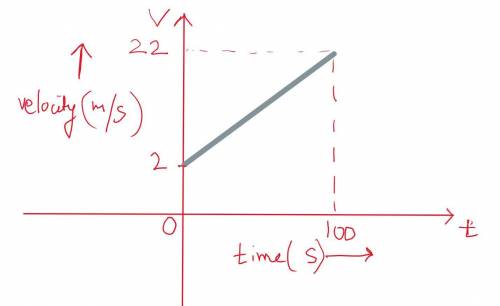The graph represents velocity over time.
a graph with horizontal axis time (seconds) and...

Physics, 15.11.2019 23:31 allhailkingmilkdud
The graph represents velocity over time.
a graph with horizontal axis time (seconds) and vertical axis velocity (meters per second). a line runs from 0 seconds 2 meters to 100 seconds 22 meters.
what is the acceleration?
–0.4 m/s2
–0.2 m/s2
0.2 m/s2
0.4 m/s2

Answers: 3


Another question on Physics

Physics, 22.06.2019 04:30
The pressure increases by 1.0 x 104 n/m^2 for every meter of depth beneath the surface of the ocean. at what depth does the volume of a pyrex (bulk modulus 2.6 x 1010n/m^2) glass cube, 9.8 x 10^−2m on an edge at the ocean's surface, decrease by 7.5 x 10−10m^3? explain the formula beyond this point: p=1.0x10^4, b=2.6x10^10, l=9.8x10^−2, delta v=7.5x10^−10. at some point l needs to be cubed. why p is divided by delta v?
Answers: 2

Physics, 22.06.2019 13:30
Which is not an example of how an object gains elastic potential energy by stretching? a. jumping on a pogo stick b. pulling on a rubber band c. jumping on a trampoline
Answers: 1

Physics, 22.06.2019 17:30
You can watch static electricity in action by rubbing an inflated balloon against your hair. your hair will actually stand on its end! it does this because each hair becomes charged, and they all repel one another.
Answers: 3

Physics, 22.06.2019 21:30
Which of these statements best explains how the hydrosphere interacts with the atmosphere to affect global climate? mountains block rain clouds and cause changes in global rainfall and evaporation. humans burn fossil fuels to produce greenhouse gases which cause global warming. humans cut down trees which affects the amount of oxygen in different parts of the globe. greenhouse gases, like carbon dioxide, dissolve in oceans and prevent global warming.
Answers: 1
You know the right answer?
Questions

English, 23.06.2019 10:00


English, 23.06.2019 10:00












Spanish, 23.06.2019 10:00

English, 23.06.2019 10:00

History, 23.06.2019 10:00

Mathematics, 23.06.2019 10:00





 .
.


